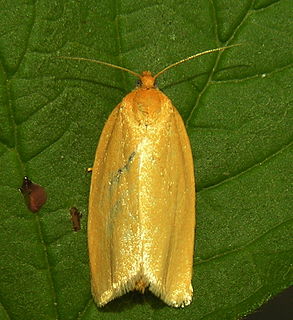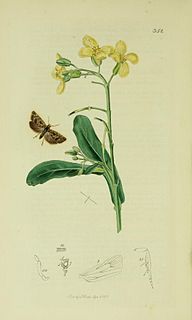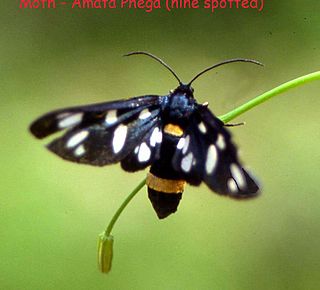Related Research Articles
In Greek mythology, Ceryx was a son of Hermes and either Pandrosus or Agraulus. He was, like his father, a messenger. But the kêryx career began as a humble cook for the tribe, a skill Hermes demonstrates in his cooked meat offerings on the Twelve Gods Altar set in place 522BC by Peisistratos III in Athens. The Homeric Hymn to Hermes 128 recalls the young god cutting out and laying up twelve steaks on a flat rock or platamoni," the 12 Gods altar.

The northern brown argus is a butterfly in the family Lycaenidae. It is found throughout much of the Palearctic realm.

Sergey Vladimirovich Obraztsov was a Soviet and Russian puppeteer who is credited by the Encyclopædia Britannica with "establishing puppetry as an art form in the Soviet Union." Puppet theaters in many countries owe their establishment to Obraztsov's influence. His collection of exotic puppets was the largest in Russia and one of the largest in the world.

Caeneressa is a genus of moths in the family Erebidae.

Ceryx is a genus of moths in the family Erebidae. It was described by Hans Daniel Johan Wallengren in 1863.

Aphelia is a genus of tortrix moths in tribe Archipini.
Pseudatteria is a genus of moths belonging to the family Tortricidae.

Selania is a genus of moths belonging to the subfamily Olethreutinae of the family Tortricidae.

Acleris is a genus of moths belonging to the subfamily Tortricinae of the family Tortricidae.
Similodonta is an extinct genus of early bivalve in the extinct family Praenuculidae. The genus is one of eleven genera in the subfamily Praenuculinae. Similodonta is known from Middle Ordovician through Middle Silurian fossils found in Europe and North America. The genus currently contains eight accepted species, Similodonta ceryx, Similodonta collina, Similodonta djupvikensis, Similodonta magna, Similodonta recurva, Similodonta spjeldnaesi, Similodonta wahli and the type species Similodonta similis.
Ceryx burgeffi is a moth of the subfamily Arctiinae. It was described by Obraztsov in 1949. It is found on Java.
Ceryx calcuni is a moth of the subfamily Arctiinae. It was described by Obraztsov in 1957. It is found on Java.
Ceryx giloloensis is a moth of the subfamily Arctiinae. It was described by Obraztsov in 1957. It is found on the Maluku Islands of Indonesia.
Ceryx homoeochroma is a moth of the subfamily Arctiinae. It was described by Obraztsov in 1957. It is found on Sumatra in Indonesia.
Ceryx javanica is a moth of the subfamily Arctiinae. It was described by Obraztsov in 1949. It is found on Java.
Ceryx morobeensis is a moth of the subfamily Arctiinae. It was described by Obraztsov in 1957. It is found in New Guinea.
Ceryx sumatrensis is a moth of the subfamily Arctiinae. It was described by Obraztsov in 1949. It is found on Sumatra.
Ceryx toxopeusi is a moth of the subfamily Arctiinae. It was described by Obraztsov in 1957. It is found on Sumatra in Indonesia.
Ceryx vespella is a moth of the subfamily Arctiinae. It was described by Obraztsov in 1957. It is found on Java in Indonesia.

The Syntomini are a tribe of moths in the family Erebidae. The tribe was erected by Gottlieb August Wilhelm Herrich-Schäffer in 1846.
References
- ↑ Savela, Markku (December 21, 2015). "Ceryx riouensis Obraztsov, 1957". Lepidoptera and Some Other Life Forms. Retrieved October 31, 2019.
| This Ceryx-related article is a stub. You can help Wikipedia by expanding it. |